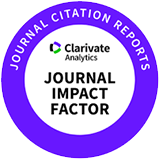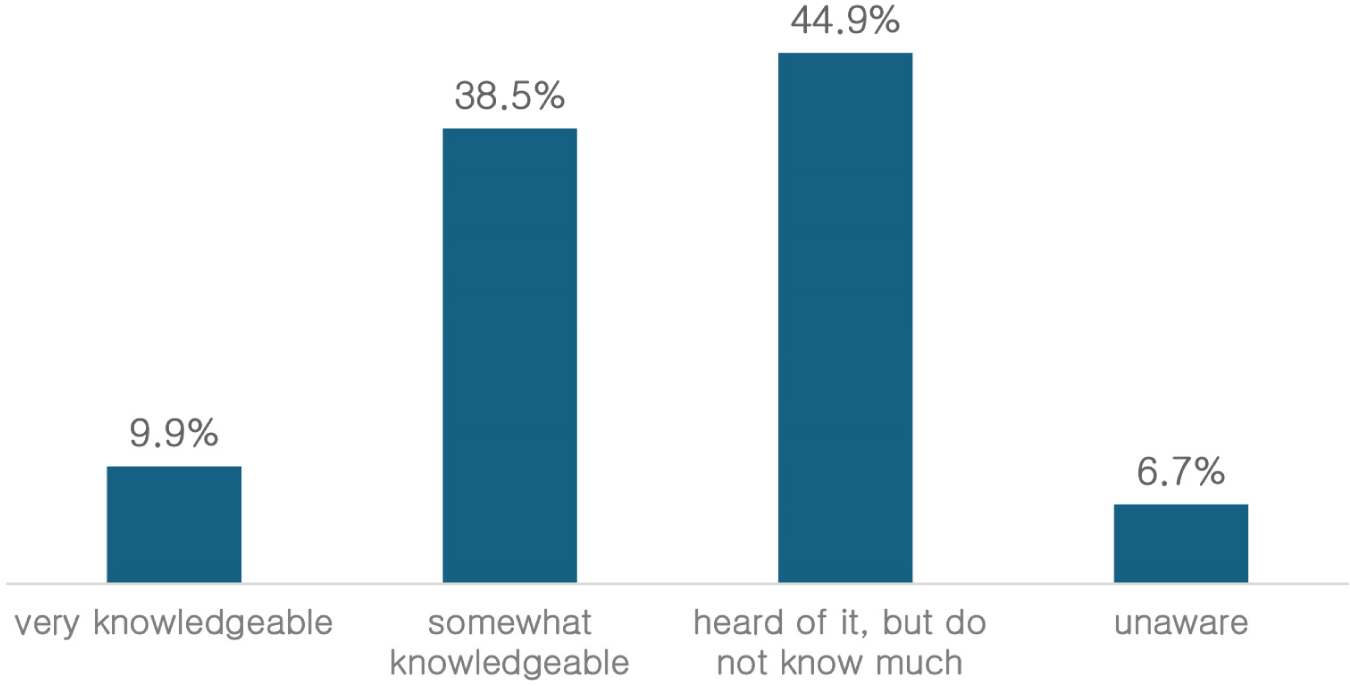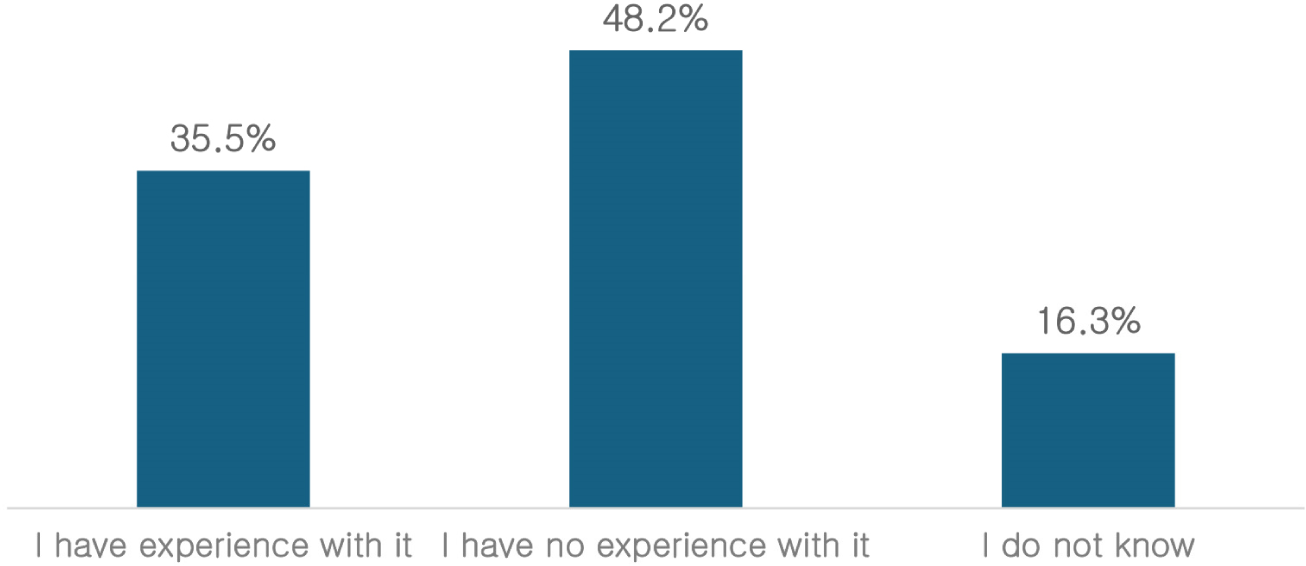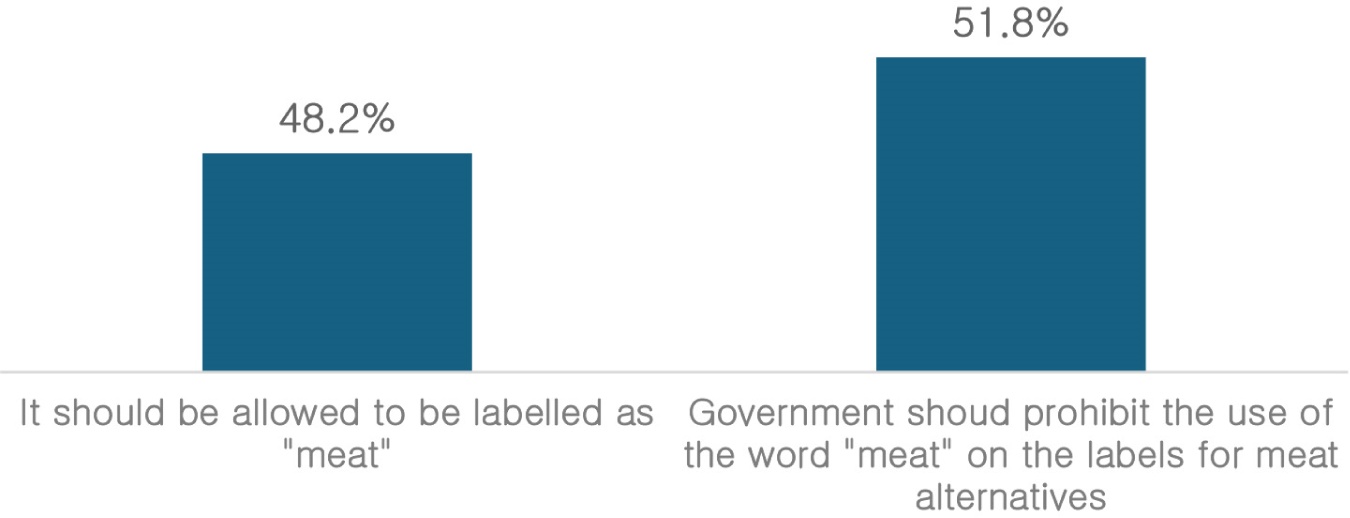Introduction
In 2021, the agricultural sector accounted for 3.2% of South Korea’s total greenhouse gas emissions, with livestock contributing 48.1% of this figure, equivalent to 1.52% of the nation’s total emissions (Greenhouse Gas Inventory and Research Center of Korea, 2024). Despite its relatively small share of overall emissions, the livestock industry is being increasingly scrutinized as a major contributor to climate change (Hur et al., 2024). This perception is exacerbated by concerns about environmental pollution from livestock waste, social conflicts arising from odors, the prevalence of animal diseases, and welfare issues associated with factory farming. Additionally, numerous domestic and international studies have linked the consumption of red and processed meat to higher disease risk, thereby negatively affecting the public’s perception of the livestock industry and meat consumption (Lee et al., 2021; World Cancer Research Fund, 2018). Several studies have indicated that excessive intake of red and processed meat may contribute to health problems (Bouvard et al., 2015; Godfray et al., 2018). Additionally, the intensive farming practices used to raise animals for food have raised concerns about animal welfare among consumers (Norwood and Lusk, 2011). As a result of these concerns, global dietary guidelines recommend that people limit their consumption of meat (Gonzalez Fischer and Garnett, 2016).
Interest in the development of meat alternatives has surged in response to growing concerns regarding the environmental and health implications of traditional meat consumption. The Ministry of Food and Drug Safety released the “Labeling Guidelines for Alternative Foods” on November 27, 2023. These guidelines define alternative foods as those manufactured using primarily plant-based, microbial, edible insect, or cell-cultured ingredients to mimic the form, taste, and texture of conventional foods. The guidelines also specify labeling the requirements and criteria for alternative foods. While some have begun using terms such as “plant-based alternatives” instead of “meat alternatives,” confusion remains regarding the scope of application and effective date of the guidelines. Given that the term “meat alternative” is still widely used by both consumers and the media, this study has adopted the term “meat alternative.” The market for plant-based and lab-grown (cultured) meat products is projected to grow substantially in the coming years. Globally, the market for meat alternatives was valued at $187.8 billion in 2023, which is anticipated to expand at a compound annual growth rate of 42.4% from 2024 to 2030 (Grand View Research, 2024).
South Korea has witnessed a significant increase in the production and consumption of meat alternatives. The domestic market for alternative foods reached 89.5 billion won in 2022, demonstrating a remarkable 48.3% annual growth rate since 2020 (Ministry of Food and Drug Safety, 2023). Major food franchises and corporations have been at the forefront of introducing meat alternatives in the South Korean market. Lotteria, a popular fast-food chain, was the first to launch a vegan burger in 2019, followed by the introduction of “Miracle Burger” and “Sweet Earth Awesome Burger” in 2020. Burger King joined the trend with its “Plant-Based Whopper.” Key food companies are actively developing plant-based meat products for their own brands. Shinsegae Food’s “Better Meat” and Lotte Wellfood’s “Zero Meat” are examples of such initiatives. Whether these burgers and plant-based meat alternatives will become successful on the market depends on whether consumes will adopt a new plant-based burgers or alternatives in their diet. Consequently, it is important to study consumers preferences for alternative meat products. Shinsegae Foods (2023) reported that 68% of Korean consumers in their 20s and 30s hold a favorable opinion of plant-based meat. While this survey shows that 49% of Korean Millennials have experience consuming plant-based meat, the survey also found that 81% of Korean Millennials indicated they were very or extremely likely to purchase novel food products.
The incursion of large corporations with expansive distribution channels and established brand recognition into the domestic meat substitute market signifies a positive impetus for industry growth (Lee et al., 2021). However, the domestic lab-grown meat market is still in its early development stage compared with international markets, and consumer products are not yet widely available. Even so, the potential of lab-based meat has gained the confidence and interest of several food tech startup companies in lab-based meat products (Lee et al., 2024).
Despite the growth in the meat alternative market, consumer preferences for alternative proteins and the potential for further market expansion remain uncertain. This study investigates consumer awareness, choice, willingness-to-pay (WTP), and preference for the term “meat alternative” regarding various meat alternative products currently available in the market. The study focuses on canned ham and compares products made from domestic pork, plant-based protein, and lab-grown meat. Canned ham was selected as the subject of the analysis because of its significant market size in South Korea, widespread consumer recognition, and the recent introduction of plant-based alternatives by major food companies such as Shinsegae Food, Pulmuone, Dongwon F&B, and CJ Cheiljedang. This has resulted in the availability of a relatively diverse range of meat alternative products to consumers in the domestic market (Money Today, 2023).
The growing interest in meat alternatives in South Korea has increased related academic studies. While most studies have focused on analyzing the market and technological advancements in alternative foods (Ham et al., 2021; Lee and Kim, 2018; Park et al., 2020; Yie et al., 2021; You et al., 2020) or consumer intentions, attitudes, and purchase intentions toward plant-based meat alternatives (Byun and Yoo, 2022; Park et al., 2019; Shin et al., 2023; Sim et al., 2022), no study investigated the consumers’ WTP or demand at alternative price points in South Korea.
This study directly analyzes consumer preferences for meat alternatives. Given the limited availability of consumer data on lab-grown meat, which is not yet commercially available, and the recent introduction of plant-based canned ham, this study employs a discrete choice experiment (DCE). The DCE involves a hypothetical purchase scenario in which consumers are presented with choices between canned ham made from pork and various plant-based alternatives at different prices. Through this method, this study aims to assess consumer awareness and purchase experience regarding meat alternatives, estimate the WTP for different products, and examine how the WTP varies across different socioeconomic groups. Finally, the study investigates consumer preferences regarding using the term “meat alternative.”
Materials and Methods
Considering the absence of lab-grown meat-based canned ham products in the market, consumer demand data are limited. This study elicits consumer preferences for meat alternatives through a nationwide survey. The survey included a DCE in which the consumers could choose between three canned ham products with different prices and types of meat or select a “none of these” option. The three canned ham products were made from domestic pork, lab-grown meat, and plant-based protein.
In the DCE, the respondents were presented with repeated choice tasks, requiring them to select their preferred canned ham product from three options. These options had five price levels ranging from ₩6,500 to ₩8,500 in ₩500 increments for a 340 g can, referencing the prices of conventional and plant-based canned hams found in actual supermarkets and grocery stores.
Each DCE question included four alternatives corresponding to the canned ham products made from three different types of meat and the “none of these” option at varying price levels. Thus, there were 53=125 possible choice questions. To reduce fatigue, in this study, an orthogonal fractional factorial design was employed and reduce the number of choice questions to 25. Then, to further reduce the 25 questions were blocked into five sets of five questions each. The respondents were randomly assigned to one of the five blocks and asked to answer five questions. Fig. 1 shows an example of a choice question in which three canned ham products with their respective ingredients were presented. Before answering the choice questions, the respondents were provided with a brief explanation of plant-based and lab-grown meat as well as a cheap talk script to reduce hypothetical bias and encourage them to consider their choices as if they were making a real purchase (Choi and Chang, 2013; Ryoo et al., 2023).
Following the DCE questions, additional questions were included to assess the respondents’ awareness level, purchase experience, and consumption of meat alternatives. For awareness level, they were asked to self-report their level of knowledge about meat alternatives on a four-point Likert scale: “very knowledgeable,” “somewhat knowledgeable,” “heard of it, but do not know much,” and “unaware.” Next, they were asked if they had purchased or consumed meat alternative products. Finally, they were asked for their opinions on using the term “meat” to refer to lab-grown or plant-based meat alternatives. The respondents were asked, “Should meat alternative products be allowed to be labeled as ‘meat’?” with two options: “Yes, it is acceptable to use the term ‘meat’” and “No, the government should prohibit the use of the term ‘meat’ because it is not real meat.”
A nationwide online survey was implemented and data were collected in September 2023. The participants were recruited using a market research company quota for regions of residence and age groups. One thousand food shoppers responded to the survey. Table 1 presents participants’ demographic characteristics. The survey sample comprised more women, primarily because the author requested responses from primary grocery shoppers, who accounted for 80% of the total sample. The respondents aged between 20 and 30 years accounted for 36% of the sample, whereas 43% were aged 50 years and older. Furthermore, 19.5% of the respondents resided in Seoul. The respondents who were single comprised 30.9% of the sample, and 22.9% lived in one-person households.
The DCE questions employed in this survey were designed based on the random utility theory (McFadden, 1973). Consumer i’s utility of choosing the alternative j is defined as
Where Vij is the systematic component of the utility function, and eij is the unobservable component. The utility of choosing the alternative j relative to the “none of these” option for respondent i is represented by the alternative-specific constant βj; α is the marginal utility of price, and Priceij is the price of the alternative j faced.
After each respondent answered five DCE questions, 1,000×5=5,000 choice observations were collected and analyzed using a random parameter logit (RPL) model to account for heterogeneity in consumer preferences. Distributional assumptions for the coefficients in Eq. (1) were required to estimate the RPL model. In this study, a normal distribution was assumed for the alternative-specific constants, reflecting the possibility of positive and negative preferences for different canned ham products. The price coefficient is assumed to follow a constrained triangular distribution to allow for variation within a limited range (Hensher and Greene, 2003; Hensher et al., 2015; Scarpa et al., 2013). This constrained or one-sided triangular distribution excludes positive values of the price coefficient, ensuring a clear representation of an increase in demand with a fall in price.
In the RPL model, the probability that consumer i chooses the alternative j can be expressed as follows (Train, 2009):
Where f(βi,αi|μ,Ω) is the probability density function of the vector of random parameters β and α, μ is a vector of price coefficients and alternative-specific constants, and Ω is the variance-covariance matrix of the random parameter vector. In the actual model estimation, simulated maximum likelihood estimation was used, with 500 Halton draws. The mean WTP for each of the three canned ham products with different ingredients was derived as the ratio of the mean coefficient of the alternative and the negative of the price coefficient obtained from the model estimation. In the RPL model, individual-specific coefficient estimates can be obtained, allowing for the calculation of individual WTP. This study conducted a simple regression analysis to examine how individual WTP values vary according to respondents’ socioeconomic characteristics (Chang et al., 2022; Train, 2009).
Results
Fig. 2 presents the self-reported awareness level of alternative meat among the 1,000 survey respondents. A significant proportion of respondents (44.9 %) indicated that they had “heard of alternative meat but do not know much about it.” Additionally, 6.7% of respondents reported being “unaware or do not know” of alternative meat, indicating that just over half (51.6%) of all respondents did not clearly understand alternative meat. Despite growing interest in alternative meat, this survey suggests that several consumers do not comprehensively understand this product.
Fig. 3 shows that 35.5% of the respondents reported having purchased or consumed alternative meat, similar to the 36% proportion found in previous studies on consumer awareness and consumption of alternative meat (Hankook Research, 2023).
Table 2 provides the descriptive statistics for the choices among three alternatives: canned ham made from domestic pork, lab-grown meat, and plant-based meat, as presented in the DCE questions. Domestic pork-based canned ham was selected most frequently (63.9%), whereas lab-grown meat was the least popular option (5.9%).
| Handon pork | Lab-grown | Plant-based | None | Total | |
|---|---|---|---|---|---|
| Count | 3,193 | 295 | 1,009 | 503 | 5,000 |
| Proportion (%) | 63.9 | 5.9 | 20.2 | 10.1 | 100.0 |
Table 3 shows the parameter estimates for the RPL model applied from the DCE. A likelihood ratio test of the null hypothesis of homogeneous preferences yields a chi-square test statistic of 7,843.524 and 7 degrees of freedom, rejecting the null hypothesis at the p<0.01 significance level. This result indicates that the RPL model provides a better fit to the data. The RPL model showed that all parameter estimates were statistically significant at the 1% level, and the price coefficient was negative, implying that an increase in price leads to a decrease in utility. The alternative-specific constants for the three types of canned ham were all positive, indicating a preference for purchasing canned ham over the “none” option, holding the price constant. Results show that consumers prefer canned ham made from domestic pork, followed by plant-based protein and lab-grown meat. Additionally, although the standard deviation estimates were relatively small, they were all statistically significant, suggesting heterogeneity in consumer preferences.
Table 4 reports the mean WTP for the three types of canned ham, derived from the estimation results in Table 3. The reported statistics are the estimated price differences that would make a consumer indifferent between two canned ham products that are otherwise identical except for the primary ingredient in question. The domestic Handon pork canned ham has the largest mean WTP (relative to “none”) and lab-grown meat has the lowest mean WTP. Results suggest that consumers were willing to pay large premiums to avoid lab-grown meat alternatives: ₩5,403 for one canned ham. This finding may be because lab-grown meat is not yet commercially available in the domestic market, leading to relatively low consumer awareness, limited purchase experience, and consequently, an inability to form strong preferences or make informed judgments. Additionally, concerns regarding the safety of lab-grown meat and uncertainties about cell culture technology may have influenced consumer preferences.
| Willingness-to-pay (won/340 g) | Random parameter logit (won) |
|---|---|
| Handon pork vs. lab-grown | 5,402.9 |
| Handon pork vs. plant-based | 3,339.9 |
| Plant-based vs. lab-grown | 2,063.0 |
Table 5 reports the results of a regression analysis examining the relationship between socioeconomic variables and individual WTP, derived from the RPL model. The results show that individuals aged 20–40 had significantly higher WTP for canned ham made from domestic Handon pork, plant-based, and lab-grown protein compared with those aged 60 and above. This finding suggests that processed meat products such as canned ham are more preferred among younger consumers.
Also the study found that younger individuals tend to have relatively stronger preferences for the plant- and lab-grown alternatives relative to farm-raised pork. Additionally, respondents with a university degree or higher had a significantly higher WTP for plant-based protein canned ham compared with those with a high school education or less. Moreover, households with a monthly income of 8 million won or more had significantly lower WTP for canned ham made from domestic pork compared with those with an income below 2 million won.
Fig. 4 summarizes respondents’ preferences regarding policy-related issues concerning alternative meat. A total of 51.8% of the respondents agreed that the use of the term “meat” (yuk in Korean) to refer to lab-grown meat or plant-based protein should be prohibited, slightly outnumbering those who disagreed. This result is negative for the livestock industry, which has long opposed the use of the term “alternative meat” for protein products or lab-grown meat aimed to replace animal products. This finding is similar to the consumer preferences in countries with more developed alternative food markets. A recent survey found that 59.1% of US consumers and 46.3% of UK consumers agreed that food companies should be allowed to use meat-related terms such as “burger,” “steak,” and “sausage” for meat-free vegetarian products (Ingredient Communications, 2019).
Discussion
Amidst growing concerns over environmental pollution caused by greenhouse gas emissions and manure, animal welfare issues arising from factory farming, and increasing consumer concerns about food safety owing to frequent outbreaks of livestock diseases, interest in alternative meat as a substitute for livestock products has surged significantly with recent advancements in food technology. As such, while some studies investigated consumer preferences or demand (Slade, 2018; Van Loo et al., 2020) or willingness to purchase intentions for lab-grown meat (Bryant et al., 2019; Wilks and Phillips, 2017), no study elicited consumers’ WTP in South Korea. This study aimed to analyze consumer preferences for alternative meat and provide basic related information.
A nationwide survey of consumers revealed that despite heightened interest, many consumers still lack accurate knowledge about alternative meat, and the experience of purchasing it is lower than that of not purchasing it. Additionally, while major food companies have recently launched products using plant-based alternative meat as the raw material, considering that most consumers are aware of these products, a survey was conducted assuming that canned ham is made from three different raw materials: domestic pork, plant-based alternative meat, and lab-grown meat. The results indicate that consumer preferences are highly heterogeneous. The preference for canned ham made from domestic pork was the highest, followed by canned ham made from plant-based alternative meat, and canned ham made from lab-grown meat. Finally, this study examined consumers’ opinions on the ongoing debate over the naming of alternative meat. The livestock industry has strongly opposed the use of the term “meat” to refer to alternative meat; in November 2023, the Ministry of Food and Drug Safety announced the establishment of “Guidelines for Labeling Alternative Foods.” The guidelines prohibit the use of the term “meat” and require the labeling of products as “alternative foods.” According to a consumer survey, 51.8% of the consumers responded that the term “meat” should not be used for alternative foods, as they are not actual meat. Given the still ongoing discussions in the US and EU regarding the appropriateness of using meat-derived terms for plant-based and lab-grown meat alternatives, further empirical research is needed to understand consumer perceptions of these labeling conventions. In summary, this study found that many consumers lack accurate knowledge about alternative foods, and their preferences are lower for alternative foods than for actual meat products. However, as consumers have relatively low levels of accurate information about the foods they purchase or consume, and as the survey indicated that those who viewed plant-based or lab-grown meat as alternatives to alternative foods may have mistaken them for actual “meat,” there is a possibility that the WTP for alternative foods was overestimated.
Conclusion
It is necessary to investigate consumers’ accurate level of awareness regarding alternative foods and analyze the differences in consumer preferences based on the provision of information on alternative foods. It would also be meaningful to examine consumers’ reactions to the provision of information on environmental and technological aspects when providing information on alternative foods. Moreover, to better understand the varying market shares of different meat alternatives, additional research is needed to identify the factors that influence consumer preferences. These factors might include personal attitudes (like neophobia or lifestyle choices), dietary habits, psychological characteristics, and knowledge or familiarity with these products. Finally, analyzing how consumer preferences for alternative foods in the form of basic livestock products, rather than the processed meat products analyzed in this study, are influenced by their socioeconomic characteristics could provide helpful information to understand various types of alternative food markets.

















